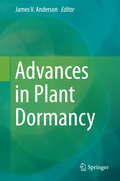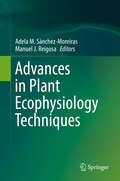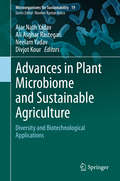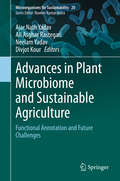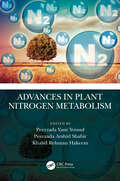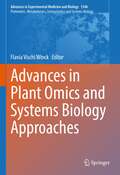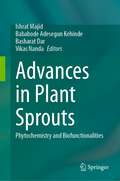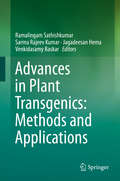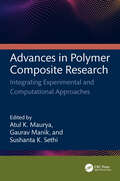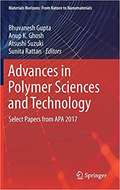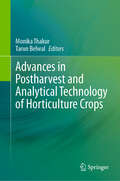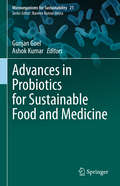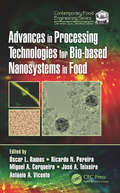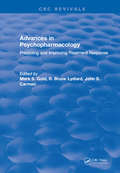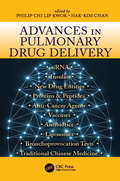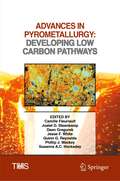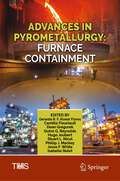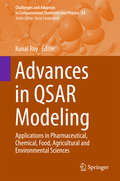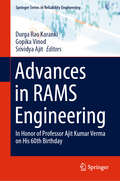- Table View
- List View
Advances in Plant Dormancy
by James V. AndersonPlant dormancy involves synchronization of environmental cues with developmental processes to ensure plant survival; however, negative impacts of plant dormancy include pre-harvest sprouting, non-uniform germination of crop and weed seeds, and fruit loss due to inappropriate bud break. Thus, our continued quest to disseminate information is important in moving our understanding of plant dormancy forward and to develop new ideas for improving food, feed, and fiber production and efficient weed control, particularly under global climate change. Proceeding from the 5th International Plant Dormancy Symposium will provide an overview related on our current understanding of how environmental factors impact cellular, molecular, and physiological processes involved in bud and seed dormancy, and perspectives and/or reviews on achievements, which should stimulate new ideas and lines of investigation that increase our understanding of plant dormancy and highlight directions for future research.
Advances in Plant Ecophysiology Techniques
by Adela M. Sánchez-Moreiras Manuel J. ReigosaThis handbook covers the most commonly used techniques for measuring plant response to biotic and abiotic stressing factors, including: in vitro and in vivo bioassays; the study of root morphology, photosynthesis (pigment content, net photosynthesis, respiration, fluorescence and thermoluminiscence) and water status; thermal imaging; the measurement of oxidative stress markers; flow cytometry for measuring cell cycle and other physiological parameters; the use of microscope techniques for studying plant microtubules; programmed-cell-death; last-generation techniques (metabolomics, proteomics, SAR/QSAR); hybridization methods; isotope techniques for plant and soil studies; and the measurement of detoxification pathways, volatiles, soil microorganisms, and computational biology.
Advances in Plant Microbiome and Sustainable Agriculture: Diversity and Biotechnological Applications (Microorganisms for Sustainability #19)
by Ajar Nath Yadav Ali Asghar Rastegari Neelam Yadav Divjot KourMicrobes are ubiquitous in nature, and plant-microbe interactions are a key strategy for colonizing diverse habitats. The plant microbiome (epiphytic, endophytic and rhizospheric) plays an important role in plant growth and development and soil health. Further, rhizospheric soil is a valuable natural resource, hosting hotspots of microbes, and is vital in the maintenance of global nutrient balance and ecosystem function. The term endophytic microbes refers to those microorganisms that colonize the interior the plants. The phyllosphere is a common niche for synergism between microbes and plants and includes the leaf surface. The diverse group of microbes are key components of soil-plant systems, and where they are engaged in an extensive network of interactions in the rhizosphere/endophytic/phyllospheric they have emerged as an important and promising tool for sustainable agriculture. Plant microbiomes help to directly or indirectly promote plant growth using plant growth promoting attributes, and could potentially be used as biofertilizers/bioinoculants in place of chemical fertilizers. This book allows readers to gain an understanding of microbial diversity associated with plant systems and their role in plant growth, and soil health. Offering an overview of the state of the art in plant microbiomes and their potential biotechnological applications in agriculture and allied sectors, it is a valuable resource for scientists, researchers and students in the field of microbiology, biotechnology, agriculture, molecular biology, environmental biology and related subjects.
Advances in Plant Microbiome and Sustainable Agriculture: Functional Annotation and Future Challenges (Microorganisms for Sustainability #20)
by Ajar Nath Yadav Ali Asghar Rastegari Neelam Yadav Divjot KourMicrobes are ubiquitous in nature, and plant-microbe interactions are a key strategy for colonizing diverse habitats. The plant microbiome (epiphytic, endophytic and rhizospheric) plays an important role in plant growth and development and soil health. Further, rhizospheric soil is a valuable natural resource, hosting hotspots of microbes, and is vital in the maintenance of global nutrient balance and ecosystem function. The term endophytic microbes refers to those microorganisms that colonize the interior the plants. The phyllosphere is a common niche for synergism between microbes and plants and includes the leaf surface. The diverse group of microbes are key components of soil-plant systems, and where they are engaged in an extensive network of interactions in the rhizosphere/endophytic/phyllospheric they have emerged as an important and promising tool for sustainable agriculture. Plant microbiomes help to directly or indirectly promote plant growth using plant growth promoting attributes, and could potentially be used as biofertilizers/bioinoculants in place of chemical fertilizers. This book allows readers to gain an understanding of microbial diversity associated with plant systems and their role in plant growth, and soil health. Offering an overview of the state of the art in plant microbiomes and their potential biotechnological applications in agriculture and allied sectors, it is a valuable resource for scientists, researchers and students in the field of microbiology, biotechnology, agriculture, molecular biology, environmental biology and related subjects.
Advances in Plant Nitrogen Metabolism
by Khalid Rehman Hakeem Peerzada Yasir Yousuf Arshid Shabir, and , PeerzadaAdvances in Plant Nitrogen Metabolism is a thoughtful, provocative, and up-to-date volume that presents important physiological, biochemical, and molecular perspectives of the nitrogen metabolism in plants and regulatory networks underlying it. The book is an attempt to team up with global leading research experts working in the field of plant nitrogen metabolism to compile an up-to-date and wide-ranging volume. The main purpose of this book is to present information on the most recent developments including the different modern approaches and methodologies that are being currently employed in the field of plant nitrogen metabolism. We trust that this comprehensive volume will familiarize readers with the detailed mechanisms of nitrogen metabolism and its regulation and the current trends in this field of study. The book offers comprehensive coverage of the most essential topics, including: Role of nitrogen and its assimilation in plants Recycling and remobilization of nitrogen during senescence Role of phytohormones in nitrogen metabolism Biological nitrogen fixation Nitrogen biofertilizers: role in sustainable agriculture Effect of stress on plant nitrogen metabolism Reactive nitrogen species (RNS) in plants Nitrogen toxicity in plants, symptoms, and safeguards Nitrogen metabolism enzymes: structure, role, and regulation Regulatory RNAs and their role in nitrogen metabolism of diazotrophs As a pivotal contribution to the field, this volume is an invaluable and up-to-date foundation for plant physiologists, plant biochemists, geneticists, molecular biologists, agronomists, environmental researchers, and students of plant science. The book can also be used for the coursework of research and master's students.
Advances in Plant Omics and Systems Biology Approaches (Advances in Experimental Medicine and Biology #1346)
by Flavia Vischi WinckIn the post-genomic era, several plant species have been sequenced and massive genomic information is now available which contributed to expand the development of novel technical strategies for the study of additional levels of biological information of plant species. This book focuses on the “omics” approaches together with systems analysis of several different plant species, which have revealed very interesting variations on the cellular responses at the protein, transcript and metabolite levels in response to changes environmental conditions. The volume covers recent technological advances in the area of “omics” and synthesizes recent findings of the field of plant “omics” and systems biology together along with techniques that can be applied for such studies.
Advances in Plant Sprouts: Phytochemistry and Biofunctionalities
by Vikas Nanda Ishrat Majid Bababode Adesegun Kehinde Basharat DarThe demand for plant foods in all global markets has been increasing along with awareness of greenhouse gases generated from animal farming, expanded sentiments against animal slaughtering and common perception of the health benefits of plant food products. Accordingly, more attention has been placed on green processing of plant foods for the optimization of their nutritional and health benefits. Sprouted vegetable products have been studied and reported in many scientific investigations to qualitatively improve the phytochemistry, enhance the nutritional profile and improve the biological functionality potentials of such vegetables beyond their initial natural states. Vegetable sprouts have been reported to possess aspects that make them serviceable for the management of metabolic syndrome disorders such as diabetes, hypertension, cancer and other health issues related to cellular oxidation of body cells, and antimicrobial bioactive components have been isolated from vegetable sprouts. Advances in Plant Sprouts: Phytochemistry and Biofunctionalities provides a singular source on recent advances in studies about the dietetic and nutraceutical potencies of vegetable sprouts and increases awareness on the possibility of processing plant foods to make them more nutritionally beneficial. Green production is another important aspect of this text since plant foods processed by sprouting are free of agrochemicals, consume less energy and utilize less manpower, making them easy to produce and environmentally friendly as well. Consumption and production of sprouted vegetables has been increasing in recent years, and this text covers the production and nutritional aspects of all the major sprout groups.
Advances in Plant Transgenics: Methods and Applications
by Ramalingam Sathishkumar Sarma Rajeev Kumar Jagadeesan Hema Venkidasamy BaskarThe green revolution led to the development of improved varieties of crops, especially cereals, and since then, classical or molecular breeding has resulted in the creation of economically valuable species. Thanks to recent developments in genetic engineering, it has become possible to introduce genes from different sources, such as bacteria, fungi, viruses, mice and humans, to plants. This technology has made the scientific community aware of the critical role of transgenics, not only as a means of producing stress tolerant crops but also as a platform for the production of therapeutics through molecular farming. This book discusses the commercial applications of plant transgenic technologies, including the use of transgenic cell culture approachesto improve the production of metabolites and high-value therapeutics as well as transgenic plants in pest management. It also explores generation of novel vectors, protein production using chloroplast engineering and the latest developments in this area, such as genome editing in plants. Featuring general discussions and research papers by leading international experts, it is a valuable resource for scientists, teachers, students and industrialists working in the field.
Advances in Polymer Composite Research: Integrating Experimental and Computational Approaches
by Gaurav Manik Sushanta K. Sethi Atul K. MauryaThis book emphasizes the importance of experimental characterization techniques and computational modeling tools in polymer composites. The topics covered include finite element analysis, computational fluid dynamics, molecular dynamics simulations, machine learning, material informatics, multiscale modeling, advanced characterization techniques, and the emerging field of nanocomposites. Each chapter provides detailed discussions, case studies, and examples to illustrate the practical application of these techniques in polymer composite research.Features: Offers a comprehensive exploration of polymer composites encompassing both experimental and computational approaches. Showcases most recent findings, methodologies, technologies, and applications in the field. Explores real-world case studies, industrial applications, and potential commercialization opportunities. Discusses the understanding, analysis, and design of polymer composites. Includes LAMMPS-, Ansys-, ABAQUS-, and Materials Studio-based simulation examples. This book is aimed at graduate students and researchers in polymers, polymer composites, and materials science.
Advances in Polymer Sciences and Technology: Select Papers from APA 2017 (Materials Horizons: From Nature to Nanomaterials)
by Anup K. Ghosh Sunita Rattan Bhuvanesh Gupta Atsushi SuzukiThis book presents select papers presented at the annual meeting of the Asian Polymer Association. The chapters in this volume document and report on a wide range of significant recent results for various applications, as well as scientific developments in the areas of polymer science and engineering. The chapters include original research from all areas of polymer science and technology with a focus on the manufacture, processing, analysis and application of long chain polymer molecules. This book will be of interest to researchers in academia and industry alike.
Advances in Postharvest and Analytical Technology of Horticulture Crops
by Monika Thakur Tarun BelwalThis book discusses advances in postharvest and analytical technology for horticulture crops and challenges to meet future needs. The horticulture crops (fruits and vegetables) need a systematic and scientific postharvest handling and management system for securing both physical and chemical attributes while prolonging their shelf life. Postharvest technologies include storage, drying, packaging, extraction of components, and preparation of juice and wine from the collected fruits and vegetables. All these postharvest technologies have emerged and evolved with time to provide meaningful solutions to minimize food loss, maintain quality, and provide fast processing of horticulture crops. Parallel development of analytical techniques has also evolved to monitor the quality of fruits and vegetables during postharvest processing and thus provide a rapid and efficient method for delivering safer food products. This book provides an overview of different postharvest technologies, their mechanisms, and their effect on the quality of horticulture crops. It also emphasizes the assessment of each advanced technology, including its limitations and advantages. Overall, this book provides techniques, research, mechanisms, advances, and challenges of postharvest and analytical technologies for horticulture crops, along with recommendations for future research directions.
Advances in Precision Instruments and Optical Engineering: Proceedings of the International Conference on Precision Instruments and Optical Engineering, 2021 (Springer Proceedings in Physics #270)
by Guixiong Liu Fengjie CenThis book highlights the new technologies and applications presented at the 2021 International Conference on Precision Instruments and Optical Engineering held in Chengdu, China from 25 to 27 August 2021. The conference aimed to provide a platform for researchers and professionals to share research findings, discuss cutting-edge technologies, promote collaborations and fuel the industrial transition of new technologies. The invited and contributed papers covered recent developments in optoelectronic devices, nanophotonic research, optoelectronic materials, precision instruments, intelligent instruments, laser technology, optical spectroscopy and other optical engineering topics. The book is intended for researchers, engineers and advanced students interested in precision instruments and optical engineering and their applications in diverse fields.
Advances in Precision Nutrition, Personalization and Healthy Aging
by Alexander G. HaslbergerThis book provides an overview on current trends and developments in precision nutrition and personalized health preservation, focussing on a field which is undergoing rapid change. Today, personalized strategies contrast generally accepted guidelines for specified groups and improved health and disease markers are shifting health care toward preventive strategies. At the same time, advances in food additives, nutraceuticals, functional, and medical foods are breaking down the traditional domains of health-related disciplines. This book aims to provide an overview on these processes, discusses arising problems, and provides an outlook on the future of personalized health care and the role of precision nutrition. It covers preliminary thoughts on what has been achieved and focusses on developments in the area of metabolic diseases, aging, and neurology. The book is intended as a primer in the field of precision nutrition and is aimed at researchers, clinicians, and students in health-related disciplines, who would like to get insights into current trends and developments in this area
Advances in Probiotics for Sustainable Food and Medicine (Microorganisms for Sustainability #21)
by Ashok Kumar Gunjan GoelThis book focuses on probiotics as sustainable foods and medicines, discussing issues such as screening and identification of probiotics, health claims, and advances in processing technologies, as well as food safety. Based on sound scientific research, the book is a unique reference resource for food scientists interested in development of probiotic based functional foods and their marketing. It will also appeal to those working in the area of regulations regarding the use of and health claims for fermented foods, both locally and globally.
Advances in Processing Technologies for Bio-based Nanosystems in Food (Contemporary Food Engineering #1)
by António A. Vicente Óscar L. Ramos Ricardo N. Pereira Miguel A. Cerqueira José A. TeixeiraNanotechnology can be used to address challenges faced by the food and bioprocessing industries for developing and implementing improved or novel systems that can produce safer, nutritious, healthier, sustainable, and environmental-friendly food products. This book overviews the most recent advances made on the field of nanoscience and nanotechnology that significantly influenced the food industry. Advances in Processing Technologies for Bio-Based Nanosystems in Food provides a multidisciplinary review of the complex mechanisms involved in the research, development, production and legislation of food containing nanostructures systems. Features: Presents the most recent advances made in the field of nanoscience and nanotechnology as applied to the food industry Discusses innovative approaches and processing technologies Shows how nanotechnology can be used to produce safer, nutritious, healthier, sustainable and environmental-friendly food products Covers the complex mechanisms involved in the research, development, production and legislation of food containing nanostructures Selected examples of nanotechnology applications in food industry are shown, focusing on advanced aspects of food packaging, processing and preservation; followed by one contribution that presents the potential commercialization and the main challenges for scale-up. Comprised of 15 chapters, this book provides much-needed and up-to-date information on the use of emergent technologies in bio-based nanosystems for foods, and serves as an ideal reference for scientists, regulators, industrialists, and consumers that conduct research and development in the food processing industry.
Advances in Psychopharmacology: Improving Treatment Response
by Mark S. GoldThe book focuses on the prediction and optimization of pharmacological treatment of psychiatric patients. Topics covered include the importance of accurate psychiatric diagnosis, medical problems which can mimic psychiatric illness, and the interface between psychiatric illness and opiate addiction and alcoholism. Current literature on predicting responses to antidepressants, lithium, antipsychotics and antianxiety agents is summarized. This practical guide also offers details on the state-of-the-art uses of blood levels in psychiatric practice for each class of drugs as well as other useful information in tables, graphs and flow charts.
Advances in Pulmonary Drug Delivery
by PHILIP CHI LIP KWOK AND HAK-KIM CHANThe respiratory tract has been used to deliver biologically active chemicals into the human body for centuries. However, the lungs are complex in their anatomy and physiology, which poses challenges to drug delivery. Inhaled formulations are generally more sophisticated than those for oral and parenteral administration. Pulmonary drug development is therefore a highly specialized area because of its many unique issues and challenges. Rapid progress is being made and offers novel solutions to existing treatment problems. Advances in Pulmonary Drug Delivery highlights the latest developments in this field.
Advances in Pyrometallurgy: Developing Low Carbon Pathways (The Minerals, Metals & Materials Series)
by Dean Gregurek Camille Fleuriault Jesse F. White Joalet D. Steenkamp Quinn G. Reynolds Phillip J. Mackey Susanna A.C. HockadayCarbon intensive industries are at a crossroads. Long-term manufacturing plans using pyrometallurgical processes all include decarbonization levers: we must solve the problem of fossil-based reduction and fossil-based power generation processes for metals production. This collection explores innovative and diverse strategies for the enablement of low carbon industries in the high-temperature metals and materials processing fields. In particular, the following processes are investigated:· Electrolysis and electrification of metallurgical processes · High-temperature electrolytic routes for metal and alloy production · Use of hydrogen and other alternative non-carbonaceous reducing agents · Biofuels and other non-fossil reagents for metallurgical applications · Direct and indirect use of solar energy in high-temperature processing · Energy efficiency and waste heat recovery concepts applied to pyrometallurgical operations
Advances in Pyrometallurgy: Furnace Containment (The Minerals, Metals & Materials Series)
by Dean Gregurek Camille Fleuriault Jesse F. White Quinn G. Reynolds Hugo Joubert Phillip J. Mackey Gerardo R. F. Alvear Flores Stuart L. Nicol Isabelle NoletThis collection explores the methods and challenges of containing corrosive and abrasive materials at extreme temperatures, whether they are used across commodities or technology specific. There is much to be learned from cross-commodity and cross-technology perspectives and this collection creates a platform for the exchange of ideas on the challenges, solutions, failures, and successes in furnace containment designs and applications while bringing together perspectives from industry, design houses, and research institutions. Topics include, but are not limited to: · Advances in furnace lining design philosophies · Advances in furnace design configurations and other design considerations · Problems experienced and their solutions implemented during construction and commissioning · Integration of new concepts into old smelters · Back to basics: refractory materials, shells, and cooling systems · Maintaining and monitoring · Process control and slag design · Lessons learned
Advances in QSAR Modeling: Applications in Pharmaceutical, Chemical, Food, Agricultural and Environmental Sciences (Challenges and Advances in Computational Chemistry and Physics #24)
by Kunal RoyThe book covers theoretical background and methodology as well as all current applications of Quantitative Structure-Activity Relationships (QSAR). Written by an international group of recognized researchers, this edited volume discusses applications of QSAR in multiple disciplines such as chemistry, pharmacy, environmental and agricultural sciences addressing data gaps and modern regulatory requirements. Additionally, the applications of QSAR in food science and nanoscience have been included - two areas which have only recently been able to exploit this versatile tool. This timely addition to the series is aimed at graduate students, academics and industrial scientists interested in the latest advances and applications of QSAR.
Advances in Quantum Mechanics: Contemporary Trends and Open Problems (Springer INdAM Series #18)
by Alessandro Michelangeli Gianfausto Dell’antonioThis volume collects recent contributions on the contemporary trends in the mathematics of quantum mechanics, and more specifically in mathematical problems arising in quantum many-body dynamics, quantum graph theory, cold atoms, unitary gases, with particular emphasis on the developments of the specific mathematical tools needed, including: linear and non-linear Schr#65533;dinger equations, topological invariants, non-commutative geometry, resonances and operator extension theory, among others. Most of contributors are international leading experts or respected young researchers in mathematical physics, PDE, and operator theory. All their material is the fruit of recent studies that have already become a reference in the community. Offering a unified perspective of the mathematics of quantum mechanics, it is a valuable resource for researchers in the field.
Advances in Quantum Methods and Applications in Chemistry, Physics, and Biology (Progress in Theoretical Chemistry and Physics #27)
by Jean Maruani Erkki J. Brändas Gerardo Delgado-Barrio Matti HotokkaAdvances in Quantum Methods and Applications in Chemistry, Physics, and Biology includes peer-reviewed contributions based on carefully selected presentations given at the 17th International Workshop on Quantum Systems in Chemistry, Physics, and Biology. New trends and state-of-the-art developments in the quantum theory of atomic and molecular systems, and condensed matter (including biological systems and nanostructures) are described by academics of international distinction.
Advances in Quantum Systems in Chemistry, Physics, and Biology: Selected Proceedings of QSCP-XXIII (Kruger Park, South Africa, September 2018) (Progress in Theoretical Chemistry and Physics #32)
by Jean Maruani Liliana Mammino Davide Ceresoli Erkki BrändasThis edited, multi-author book gathers selected, peer-reviewed contributions based on papers presented at the 23rd International Workshop on Quantum Systems in Chemistry, Physics, and Biology (QSCP-XXIII), held in Mopani Camp, The Kruger National Park, South Africa, in September 2018. The content is primarily intended for scholars, researchers, and graduate students working at universities and scientific institutes who are interested in the structure, properties, dynamics, and spectroscopy of atoms, molecules, biological systems, and condensed matter.
Advances in RAMS Engineering: In Honor of Professor Ajit Kumar Verma on His 60th Birthday (Springer Series in Reliability Engineering)
by Srividya Ajit Durga Rao Karanki Gopika VinodThis book surveys reliability, availability, maintainability and safety (RAMS) analyses of various engineering systems. It highlights their role throughout the lifecycle of engineering systems and explains how RAMS activities contribute to their efficient and economic design and operation. The book discusses a variety of examples and applications of RAMS analysis, including: • software products; • electrical and electronic engineering systems; • mechanical engineering systems; • nuclear power plants; • chemical and process plants and • railway systems. The wide-ranging nature of the applications discussed highlights the multidisciplinary nature of complex engineering systems. The book provides a quick reference to the latest advances and terminology in various engineering fields, assisting students and researchers in the areas of reliability, availability, maintainability, and safety engineering.
Advances in Radiation Oncology in Lung Cancer (Medical Radiology)
by Branislav JeremicThis is the second, completely updated edition of a comprehensive book in which many of the world's leading lung cancer specialists discuss the recent advances in the radiation oncology of lung cancer and reflect on the latest research findings. The first three sections cover the basic science of lung cancer, clinical investigations, including histology and staging, and a wide range of fundamental treatment considerations. Current treatment strategies for small cell and non-small cell lung cancer are then explained and evaluated in detail, with due attention to novel approaches that promise further improvements in outcome. The various types of treatment-related toxicity are discussed, and quality of life studies and prognostic factors are also considered. After evaluating the latest technological and biological advances, including IMRT, IMAT, cyber knife treatment, and tomotherapy, the book concludes by thorough consideration of specific aspects of clinical research in lung cancer.
